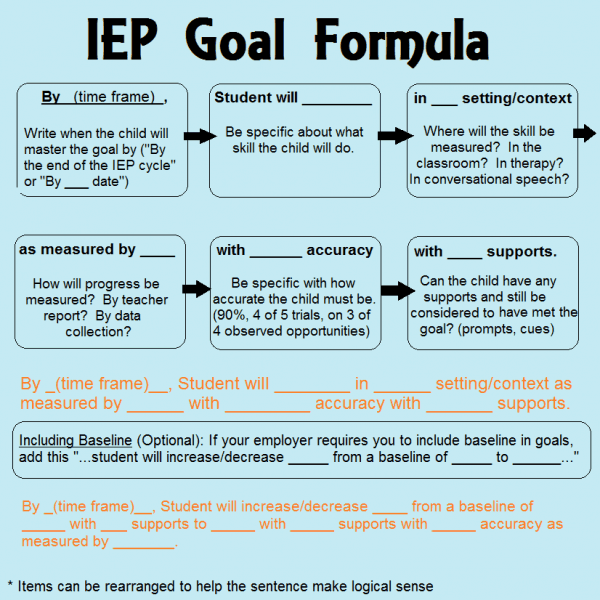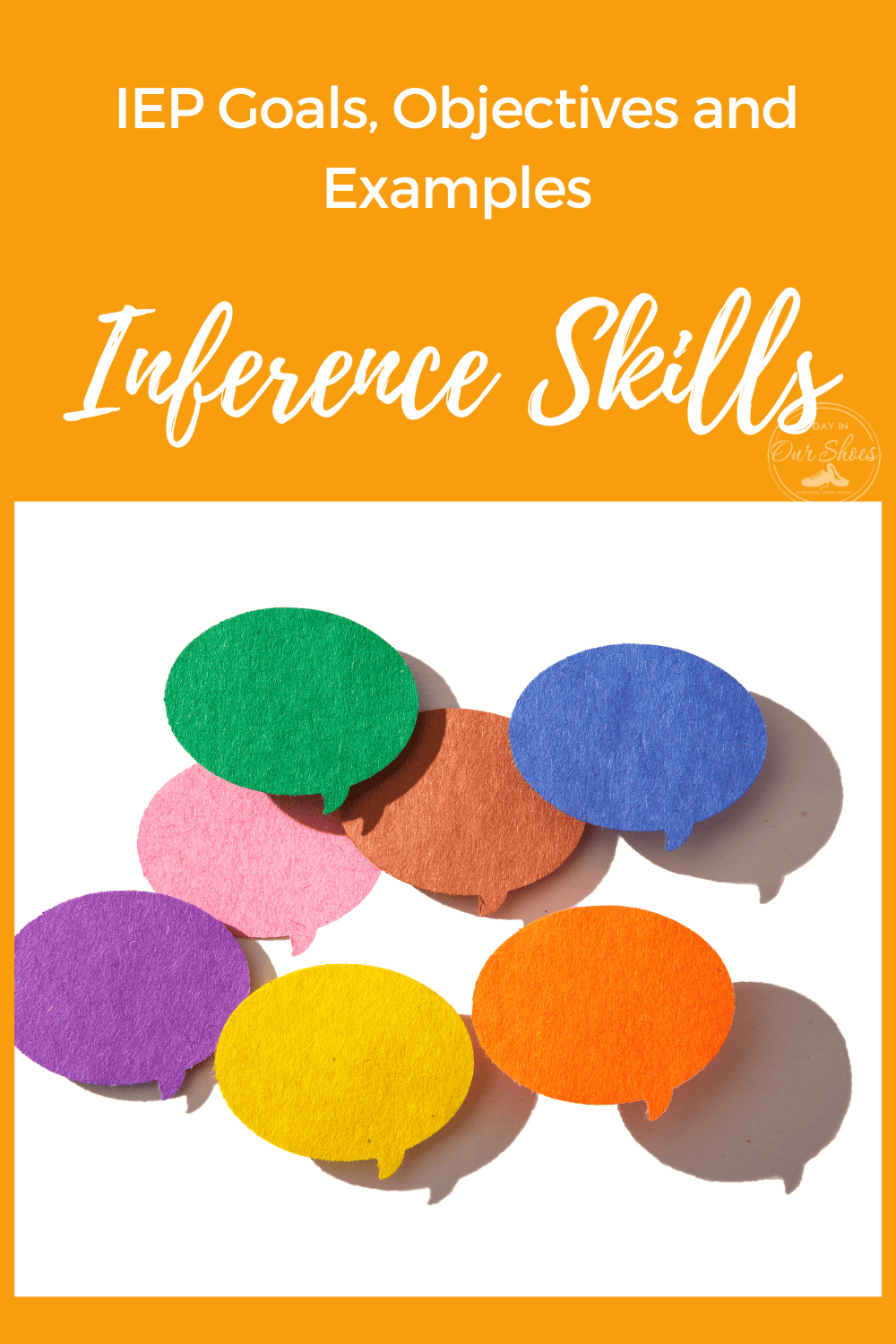13 Inference IEP Goals and Objectives
“Mommy, is that Lady Gaga?”
When my youngest was a toddler, he LOVED Lady Gaga. I have no idea why or where it came from, but he did. He would ask me to put videos of her on my computer. So, when we were watching the Super Bowl one year, the year that Madonna did the halftime show, he asked me that question.

It turned out not to be just an innocent question, but a stellar example of inference, and the definition of inference.
Not a crazy question, really.

Read: How to Teach Inference for Kids
In a preschooler’s head, they look the same, right? Heck, Lady Gaga has been accused of copying Madonna.
Another time we were walking on the OCNJ boardwalk and we passed by two older ladies wearing beach hats and big sunglasses. “Look Mommy! TWO Lady Gagas!” he exclaimed.
What is Inference?
Again, not an unreasonable inference. In both cases, he drew from his previous knowledge base (watching Gaga on TV and on my computer) and combined it with the information that was being presented to him at that moment.
As you can see from the pictures below, it’s not difficult to think of Lady Gaga (pictured on right) when you see a woman wearing a large beach hat and sunglasses.
Since he was only 3 years old during that Super Bowl, he did not have any Madonna knowledge in his knowledge base, only Lady Gaga.

Inference. When you have the skill, it often is invisible. But when a student lacks the skill, yikes. It can be difficult to define, difficult to explain, and most importantly, very difficult to teach to a child for whom this skill doesn’t naturally occur or evolve.
Definition of Inference for Kids
A pop culture example of someone who lacks inference skills is Sheldon on Big Bang. Or, it’s thought and joked about that he lacks inference skills.

However, he doesn’t really lack inference skills, his inferences are just different than many other peoples’ due to his different view or perspective (neurodivergence).
This is an area where many students will struggle. Because of their neurodivergence, they will come to different conclusions, or inferences, than what is expected or what other students will infer.
Lacking inference skills and inferring what is not expected are two different things.
Though in the short clip below, Sheldon does a good job of explaining infer vs. imply.
Think of it as to imply is the person who is the doer. Infer is the person who is receiving the information.
It is the act of taking your previous knowledge base and combining it with the information being presented to you to draw a conclusion. In the school setting, it is often used with literature. Students are asked to draw from their existing knowledge base and whatever information the author has presented them to draw a conclusion.
But it’s also an important life skill, in that we all need to be able to mesh together our previous knowledge with what is being presented to us in the moment. And not all kids can do that.
Inferences in Literature and Reading
Inference is a valuable reading comprehension skill, and it can be found in many children’s books. Here are four examples of inference in children’s literature:
- “Charlotte’s Web” by E.B. White: In this classic novel, readers can infer that Wilbur the pig is feeling lonely and scared when he first arrives at the barn because he is separated from his family and placed in a strange new environment. This inference is drawn from Wilbur’s actions and the descriptions provided in the text.
- “Harry Potter and the Sorcerer’s Stone” by J.K. Rowling: In the Harry Potter series, readers often have to infer characters’ motivations and feelings. For example, readers can infer that Severus Snape has a complex and mysterious past that affects his behavior, as his actions and interactions with other characters hint at hidden motives.
- “The Very Hungry Caterpillar” by Eric Carle: In this picture book, young readers can infer the life cycle of a butterfly by observing the gradual transformation of the hungry caterpillar into a chrysalis and then into a butterfly. The text does not explicitly state the process, but readers can make inferences based on the illustrations and the caterpillar’s activities.
- “Where the Wild Things Are” by Maurice Sendak: In this story, the main character, Max, is sent to bed without supper and then embarks on an imaginative journey to the land of the Wild Things. Readers can infer that Max’s wild adventure is a product of his vivid imagination and a way of dealing with his feelings of anger and frustration.
In all of these examples, inference allows young readers to go beyond the literal words on the page and understand the characters’ emotions, motivations, and the broader themes of the stories.
It encourages critical thinking and engagement with the text.
Here is a graphic explaining inference in literature:

And here is one, that while the graphic says ‘characters’ you can see how inference is applied in every day life.

It can make a parent crazy! If you find yourself saying in your head, “Why did my child do that? Why can’t they see…. Didn’t I just…. Don’t they know….” The answer is no, they may not be able to infer.
Definition of Inference for Kids
From the Dictionary: An inference is an idea or conclusion that’s drawn from evidence and reasoning. Inferencing is making an educated guess, a choice, a decision.
For kids, an inference is like making an educated guess based on clues or information you have. It’s when you use what you already know and what you see or read to figure out something that might not be directly stated.
It’s a way to draw conclusions or understand things that aren’t explicitly explained. Inferences help you make sense of stories, situations, or problems by using your imagination and your knowledge.
It’s a bit like being a detective and piecing together the missing pieces of a puzzle to understand the whole picture.
Teaching Inference to Kids
Inference is about applying previous knowledge, which is a skill many learning disabled students lack. Still, there are many online resources for teaching inference to kids.
IEP Goals for Making Inferences
If your child lacks the skill to infer or seems to be having trouble developing this skill, it should be noted as an area of need and put in the IEP. Again, the skill to infer is often a skill that we take for granted, but it is a valuable and necessary life skill.
- IEP goal banks, including inference.
Inference is a skill that children develop as they progress in reading. It’s one of the steps from simple decoding to full comprehension. If this is an area where you see your child struggling, I have assembled a list of resources for you to check out that may help you.

Here are some other IEP goals for inferencing skills. These are very broad and should be individualized to the child’s needs and present levels.
Inferencing IEP Goals
Here is what is listed in Common Core Standards for Reading and Inferencing.
- Grade 4 (Reading Standard): Refer to details and examples in a text when explaining what the text says explicitly and when drawing inferences from the text.
- Grade 5 (Reading Standard): Quote accurately from a text when explaining what the text says explicitly and when drawing inferences from the text.
- Grade 6 (Reading Standard): Cite textual evidence to support analysis of what the text says explicitly as well as inferences drawn from the text.
- Grade 7 (Reading Standard): Cite several pieces of textual evidence to support analysis of what the text says explicitly as well as inferences drawn from the text.
- Grade 8 (Reading Standard): Cite the textual evidence that most strongly supports an analysis of what the text says explicitly as well as inferences drawn from the text.
- Grades 9-10 (Reading Standard): Cite strong and thorough textual evidence to support analysis of what the text says explicitly as well as inferences drawn from the text.
- Grades 11-12 (Reading Standard): Cite strong and thorough textual evidence to support analysis of what the text says explicitly as well as inferences drawn from the text, including determining where the text leaves matters uncertain.
You would need to plug the skill into the IEP Goal Formula above to make it measurable.
Inference IEP Goals
Here are six example IEP goals related to inferencing skills:
- Reading Comprehension: By the end of the IEP period, when given a grade-appropriate text, the student will make at least three accurate inferences about characters, events, or plot elements in the story with 80% accuracy in three consecutive sessions.
- Predictive Inference: Over the course of the IEP, the student will demonstrate the ability to predict outcomes and events within texts. The student will make predictions based on textual evidence in at least four out of five opportunities with 90% accuracy.
- Cause and Effect Inferences: Within the IEP timeframe, the student will improve their ability to identify cause-and-effect relationships within a text. They will correctly identify cause-and-effect pairs in grade-level reading passages at a rate of 70% or higher.
- Drawing Inferences from Pictures: By the end of the IEP period, the student will be able to make inferences from pictures or illustrations in stories or non-fiction texts. They will accurately infer information from visuals in at least four out of five opportunities.
- Critical Thinking and Problem Solving: Over the course of the IEP, the student will enhance their critical thinking and problem-solving skills by making logical inferences in various subjects. The student will demonstrate this ability in at least three subject areas (e.g., reading, science, social studies) with 80% accuracy.
- Inference in Social Situations: By the end of the IEP period, the student will improve their ability to make inferences in social situations. They will accurately infer the emotions, intentions, or thoughts of others in social interactions in at least three out of four opportunities.
Inference IEP Goals and Objectives
Here are six IEP (Individualized Education Program) goals and objectives for improving inference skills in a student:
- Goal: The student will improve their ability to make inferences in reading comprehension.
- Objective 1: Given a short passage or paragraph, the student will identify and explain at least two implicit details or inferences within the text during weekly reading comprehension assessments.
- Objective 2: The student will be able to use context clues to make predictions about the outcome of a story or the meaning of unfamiliar words in a text with 80% accuracy over a 3-month period.
- Goal: The student will enhance their ability to draw conclusions from written information.
- Objective 1: When provided with a set of facts or information, the student will accurately draw at least one valid conclusion from the given data during weekly problem-solving activities in math and science.
- Objective 2: In written responses to questions, the student will provide evidence-based explanations to support their conclusions in social studies and science assignments.
- Goal: The student will develop their inference skills in everyday conversations and social interactions.
- Objective 1: In small group discussions or conversations, the student will demonstrate an improved ability to make appropriate inferences about people’s emotions, thoughts, and intentions with minimal prompting.
- Objective 2: During social skills training sessions, the student will practice identifying social cues and making inferences about peer interactions, aiming to achieve an 80% accuracy rate in recognizing non-verbal cues and social expectations.
- Goal: The student will enhance their ability to make inferences in visual media.
- Objective 1: The student will watch short video clips or movies and accurately identify key plot points or character motivations through discussion or written reflection.
- Objective 2: When presented with images or artwork, the student will write or verbalize inferences about the scene or the emotions of depicted characters with increasing accuracy.
- Goal: The student will generalize inference skills across various subject areas.
- Objective 1: The student will transfer their ability to make inferences from reading comprehension to science, history, and literature classes, as demonstrated by consistently improved performance on subject-specific assignments.
- Objective 2: The student will use inference skills to solve word problems in mathematics, making logical connections between mathematical concepts and real-world scenarios.
- Goal: The student will improve critical thinking skills through inference development.
- Objective 1: In guided critical thinking exercises, the student will analyze complex scenarios, identify relevant information, and make valid inferences, demonstrating growth in their ability to think critically and problem-solve.
- Objective 2: The student will participate in debates or structured discussions, actively engaging in critical thinking and presenting well-supported arguments that involve inferences based on available evidence.
These IEP goals and objectives aim to address different aspects of inference skills development across various contexts and subject areas to support the student’s overall academic and social progress. It is essential to tailor them to the specific needs and abilities of the student.
- Emotional Self-Regulation IEP Goals
- Study Skills IEP Goals
- Focus and Attention IEP Goals
- Inference IEP Goals
- Working Memory IEP Goals
- Task Initiation IEP Goals
- Impulse Control IEP Goals
- Work Completion IEP Goals
- Executive Functioning IEP Goals
- Free IEP Goal Bank with 1000+ Measurable IEP Goals and Objectives separated by Domain



